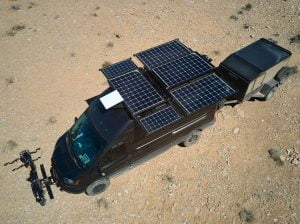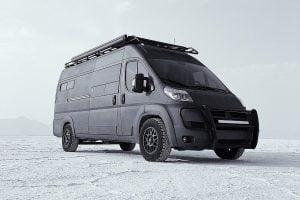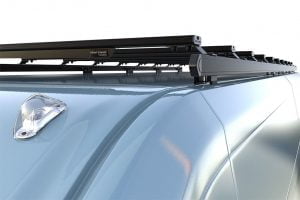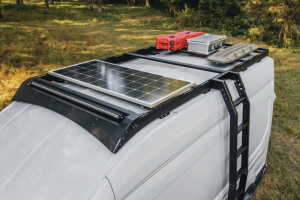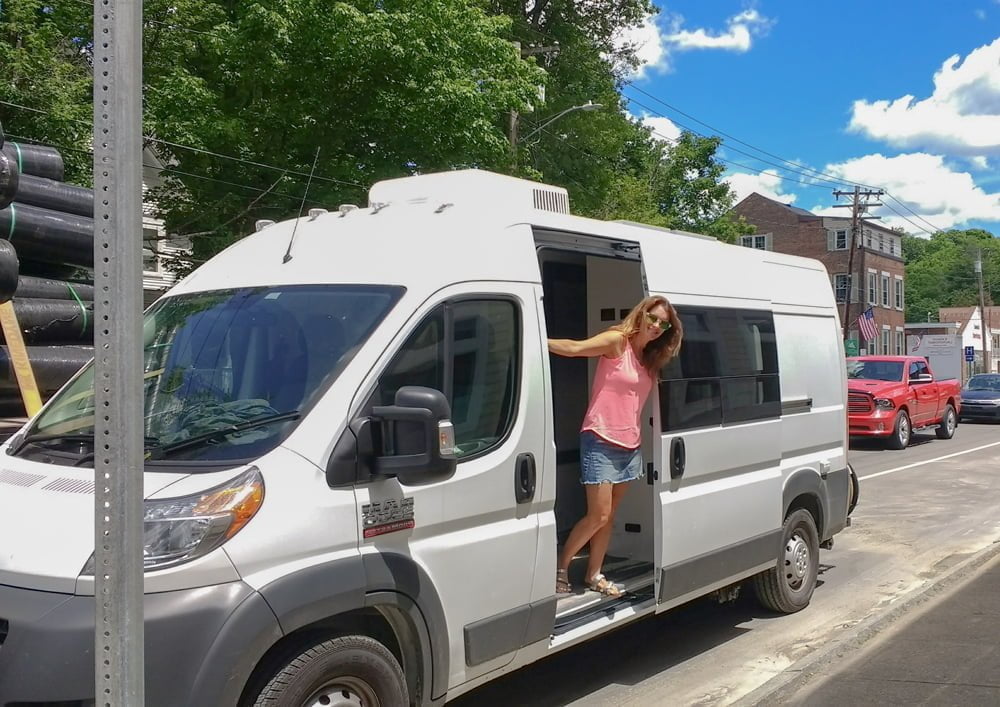Roof racks are a versatile addition to any camper van, providing extra storage space for gear and equipment, an extra place to hang out and a great way to mount things like solar panels or a Starlink dish without making necessary holes in your roof. However, with so many options available, choosing the right roof rack can be a daunting task. In this guide, I’ll walk you through the key factors to consider when selecting a roof rack for your camper van.
Some of the factors that should be considered when choosing a roof rack are budget, weight, compatibility, durability, appearance, and ease of installation. At the end of the post, I’ll rank the different types of roof racks based on each of those factors individually and you can let me know what you think as well.
Types of Roof Racks
Roof racks come in various types, including crossbar systems, prefab or semi-custom racks, DIY systems made from 8020 or unistrut, basket-style racks, racks intended for commercial use and platform racks.
The three most common types of roof racks typically used in camper van applications that we will be evaluating in this blog post are:
- Prefab/semi-custom rack systems
- Crossbar rack systems
- Homemade rack systems
I’ve owned two out of three of these types of roof racks (and you’ll see what I think about the third type at the end of this guide). On my first van (Boondocker 1.0) I did a Prefab/semi-custom rack because back in 2016, crossbar systems and homemade systems weren’t really available. On my second van (Boondocker 2.0) I did a homemade Unistrut system, which I discuss in more detail below. On my third van (Boondocker 3.0, if you couldn’t guess) I did yet another homemade system made of 80020. I haven’t owned a crossbar system, yet, but they weren’t super common even a few years ago when I was buying parts for Boondocker 3.0. But keep reading and you’ll find out what regrets I have and what roof rack I recommend for most camper vans!
Below is an example of a homemade rack system made completely of black 8020 Aluminum with composite decking mounted to the top. An aftermarket ladder was added to access the roof rack.
Budget
Roof racks can vary widely in price, so it’s important to consider your budget when choosing one for your camper van. Keep in mind that investing in a high-quality roof rack can save you money in the long run by providing reliable performance and durability. Cheaping out on a roof rack might leave you with more headaches than you need in your life.
Prefab/semi-custom racks are typically the most expensive racks and require lots of planning and patience while the roof rack is custom-made or assembled for your particular project. These roof racks usually need to be shipped via freight and installed by a professional installer. The shipping and installation add a lot of additional cost to an already expensive rack. These racks range anywhere from $3,500 to $10,000 (not including shipping and installation)
Crossbar rack systems are the “mama bear” option when it comes to price. These types of racks provide the perfect combination of appearance, weight, adjustability, and ease of installation for a relatively reasonable price. They aren’t going to be the most economical option, but for what you get, they’re a great value. These racks can range anywhere from $1500 to $3000 (usually includes free shipping and can be DIY installed).
Homemade rack systems are the most economical type but also require the most work and planning. Depending on what value you put on your time, this type of rack might end up costing you more in the long run. I’ve seen people make roof racks from all sorts of materials, but the most common two are unistrut and 8020. Unistrut can be found at Grainger or Home Depot and is steel track usually used to hang conduit. 8020 is a slotted type of extruded aluminum that can be used in a variety of applications (think erector set for grown-ups). Unistrut is going to be the most economical option. These racks can range from $500 to $2500 for all the parts usually including free shipping (or local pickup/purchase) and can be DIY installed.
Compatibility:
Not all roof racks are compatible with all camper vans. Before making a purchase, check to see if the roof rack is designed to fit your specific make and model of camper van. You should also consider any modifications that may be required for installation.
Prefab/semi-custom racks might look the best (subjectively), they don’t really allow for easy changes or adjustments in the future. They can typically be custom-made for any van make or model and can be customized to your needs. For this reason, they can be highly compatible, but as you’ll see so are the other options. In fact, since they are not easily modified after they have been installed, we would argue that they are less compatible.
Crossbar rack systems are made for most cargo van makes and models and usually consist of two side rails or walls that utilize crossbars. The crossbars can be moved up and down the side rails to accommodate a wide variety of layouts, decking, gear, solar panels, etc. Many of the crossbar rack system manufacturers now have many different accessories such as ladders, light mounts, gear storage, decking, etc that can be added to the base crossbar rack system.
Homemade rack systems are grown-up erector sets and your only limitation is your imagination. You can mix and match lengths and sizes to create anything you want. There’s literally no limit to the rack you can make with this type of system. Here’s a photo of a rack below that was made by Joe, a friend of Vanlife Outfitters who created a rack from 8020 that deploys retractable solar panels when he’s not in motion.
Durability
Since your roof rack will be exposed to the elements, it’s important to choose one that is durable and built to last. Look for roof racks made from high-quality materials such as aluminum or steel, and consider opting for a powder-coated finish for added protection against rust and corrosion.
Prefab/semi-custom racks These types are racks are made with high-quality tube aluminum welded together by professionals and powder coated. As the price suggests, these are going to be the most rugged and durable roof rack options on the market. These are usually made to be walked on, hold heavy gear, and anything else you can throw at it. You can see the rack from Boondocker 1.0 below (an Aluminess Rack) which was an extremely durable rack.
Crossbar rack systems are typically made with some combination of thick gauge, powder-coated aluminum rails for the side pieces joined together with 8020 or some other type of proprietary crossbars (but usually 8020). These are great for holding solar panels and you can also add decking or platform panels, but they definitely feel a little less sturdy when walking on the roof compared to a prefab/semi-custom roof rack. Overall the durability is pretty good, but bolts and nuts are not going to be as durable as welded, powder-coated tube aluminum.
Homemade rack systems can be dependent on what material you use, but overall they’re going to be the least durable option. I’ve seen a lot of people making roof racks out of Unistrut but I feel like it’s a bad idea because it’s made of steel which is much heavier compared to aluminum, but mainly because steel (even galvanized) is much more prone to rust and corrosion than aluminum. For better durability, 8020 is going to be much lighter and more durable than Unistrut.
Ease of Installation
Some roof racks require professional installation, while others can be installed easily with basic tools. Consider your DIY skills and comfort level with installation when choosing a roof rack for your camper van.
Prefab/Semi-Custom Racks typically need to be built off-site, shipped, and installed by a professional. For this reason, one might say the ease of installation would be very easy since you are having someone else install it. I don’t look at it that way. You have to work with the manufacturer to plan the exact layout correctly, then you have to wait between 2-5 months while your roof rack is being fabricated, then you have to coordinate the shipping and installation with the installer, then if there is any issue with the rack in the future, it would be a logistical nightmare having to take it off and or modified. For these reasons, I would rank it fairly low in terms of ease of installation as the entire process is very lengthy and stressful, even though you probably aren’t doing the physical installation yourself.
Crossbar rack systems typically come in a flat-packed box with an easy-to-follow installation manual and/or video. Since the system is flat-packed it’s easy to get all the parts up onto the roof individually, so you don’t need to be an Olympic weightlifter. All of the measuring, cutting, and hardware picking has already been done for you. If you can put together an Ikea shelf, chances are you will be able to handle a roof rack system like this in about six hours or less. You can see the Front Runner SlimPro Rack below. This is an extremely easy rack to assemble. It’s available for Mercedes Sprinter, Ram Promaster and Ford Transit.
Homemade rack systems are easy to put together (similar to a crossbar system), but the only problem is that you’ll need to design, plan, measure, cut all your pieces, and figure out what hardware you’ll need as well. For that reason, I don’t feel like it’s a great option given the emergence of crossbar systems. But, some people enjoy doing that work and would also rather save money so I understand that this option appeals to them.
Appearance
The appearance of your roof rack can be an important factor, especially if you want your camper van to make a statement on the road. Adding a roof rack, while reducing the “stealth factor” of your van, can also be a great way to hide some of your unsightly things like air conditioners, solar panels, and vent fans.
Prefab/semi-custom racks are designed to fit your camper van perfectly, enhancing its overall look. They are often sleek and streamlined, blending seamlessly with the contours of your vehicle. Custom roof racks can also be customized with various finishes, such as powder coating or anodizing, to match your camper van’s color scheme or add a unique touch. Additionally, custom roof racks are typically made from high-quality materials, giving them a premium appearance that can elevate the rugged aesthetic appeal of your camper van.
Crossbar rack systems, while they may not offer the same level of customization as prefab/semi-custom roof racks, come in a variety of styles and finishes to suit your preferences. Some crossbar roof racks feature a low-profile design, which can enhance the overall appearance of your camper van. Many options on the market, include a wind fairing which can further reduce wind resistance and improve aerodynamics. Below is an example of a crossbar rack system (the Backwoods Adventure Mods Driftr Rack) that I think it incredibly good-looking, is easy to assemble and comes in at a very reasonable price. It’s available for Mercedes Sprinter, Ram Promaster and Ford Transit.
Homemade rack systems may not have the same level of polish as custom or crossbar roof racks, but they can be customized to suit your needs and style. With some creativity and ingenuity, you can create a homemade roof rack that not only looks great but also provides the functionality you need for your outdoor adventures.
A word on Additional Features
Depending on your needs, you may want to look for roof racks with additional features such as built-in lighting, and integrated locks. These features can enhance the functionality and convenience of your roof rack. Most rack systems have additional brackets available for features that can be added whether it’s prefab/semi-custom, crossbar, or homemade. If you have specific needs don’t hesitate to reach out to me to see if something exists for your use case if you haven’t been able to find it.
Summary
I’ve owned a prefab/semi-custom roof rack and I’ve owned a couple of homemade roof racks, but if I was a building today, I would choose a crossbar roof rack system. They simply weren’t widely available in 2021 when I was purchasing materials for Boondocker 3.0. If they had been more widely available I would have chosen one for its ease of installation, appearance, compatibility, durability and reasonable prices. I would probably choose something like the Backwoods Driftr system (available for Promaster, Sprinter & Transit) for it’s rugged and versatile appearance. If I was looking for something a little more understated and low profile, I would probably opt for the Front Runner SlimPro Roof Rack (available for Promaster, Sprinter & Transit).
Feel free to check out all of our roof rack options HERE and let me know what you think. I’d love to hear your thoughts or if you have any questions about roof racks, please don’t hesitate to reach out.


